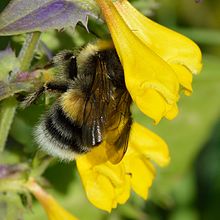Grove quail wheat
| Grove quail wheat | ||||||||||||
|---|---|---|---|---|---|---|---|---|---|---|---|---|

Grove quail wheat ( Melampyrum nemorosum ) |
||||||||||||
| Systematics | ||||||||||||
|
||||||||||||
| Scientific name | ||||||||||||
| Melampyrum nemorosum | ||||||||||||
| L. |
The grove quail wheat ( Melampyrum nemorosum ) is a species of the genus quail wheat ( Melampyrum ) in the family of the summer root plants (Orobanchaceae).
description
Vegetative characteristics
The grove quail wheat is an annual herbaceous plant that usually reaches heights of 10 to 30, rarely up to 60 centimeters. The leafy, upright stem is heavily branched.
The opposite arranged leaves are divided into a petiole and a leaf blade. With a width of 15 to 35, the entire leaf blade is rarely egg-lanceolate up to 40 millimeters.
Generative characteristics
The flowering period extends from May to September. The inflorescence contains one-sided, yellow flowers; broad, heart-shaped, blue-violet overflowing bracts above form a striking color contrast to these. The calyxes are hairy woolly and shaggy and the calyx teeth are triangular-lanceolate.
The number of chromosomes is 2n = 18.
ecology
Since the roots of the grove quail-wheat dig into the roots of neighboring grasses and thus deprive them of water and nutrients, it is counted as a semi-parasite . The fleshy appendix of the wheat-grain-like seeds is eaten by ants . The origin of part of the name is probably due to the similarity of the seed with the wheat grain .
The grove quail wheat is attacked by the rust fungi Coleosporium melampyri and Cronartium flaccidum with uredia and telia .
Occurrence
Melampyrum nemorosum is widespread in Eurasia . The grove quail wheat can be found in the European-Siberian region from the lowlands to the mountains. It does best in the partial shade of bushes and forest edges. He is in Central Europe, a federation characteristic species of Carpinion that occurs often enriched in Origanetalia hems or Prunetalia companies.
Taxonomy
The first publication of Melampyrum nemorosum was by Carl von Linné . Synonyms for Melampyrum nemorosum L. are: Melampyrum debreceniense Rapaics , Melampyrum moravicum Heinr. Brown , Melampyrum nemorosum subsp. debreceniense (Rapaics) Soó , Melampyrum nemorosum subsp. moravicum (Heinr. Braun) Čelak. , Melampyrum nemorosum subsp. silesiacum Ronniger , Melampyrum nemorosum subsp. zingeri Ganesch.
literature
- Hans Christian Weber: Parasitism of flowering plants . Scientific Book Society, Darmstadt 1993, ISBN 3-534-10529-X .
- Hans Christian Weber: Schmarotzer: Plants that live on others . Belser, Stuttgart 1978, ISBN 3-7630-1834-4 .
Individual evidence
- ↑ a b c d e Melampyrum nemorosum L., Hain quail wheat. In: FloraWeb.de.
- ↑ a b Erich Oberdorfer : Plant-sociological excursion flora for Germany and neighboring areas. 8th edition, Stuttgart, Verlag Eugen Ulmer, 2001, ISBN 3-8001-3131-5 . Page 848-849.
- ↑ Peter Zwetko: The rust mushrooms Austria. Supplement and host-parasite directory to the 2nd edition of the Catalogus Florae Austriae, III. Part, Book 1, Uredinales. (PDF; 1.8 MB).
- ↑ Kaitera, J. and Nuorteva, H. (2003), Cronartium flaccidum produces uredinia and telia on Melampyrum nemorosum and on Finnish Vincetoxicum hirundinaria. Forest Pathology, 33: 205-213. doi : 10.1046 / j.1439-0329.2003.00321.x
- ↑ a b Karol Marhold, 2011: Scrophulariaceae : Datasheet Melampyrum nemorosum In: Euro + Med Plantbase - the information resource for Euro-Mediterranean plant diversity.
Web links
- Grove quail wheat . In: BiolFlor, the database of biological-ecological characteristics of the flora of Germany.
- Profile and distribution map for Bavaria . In: Botanical Information Hub of Bavaria .
- Melampyrum nemorosum L. In: Info Flora , the national data and information center for Swiss flora . Retrieved March 14, 2016.
- Map of the entire area
- Thomas Meyer: Quail wheat data sheet with identification key and photos at Flora-de: Flora von Deutschland (old name of the website: Flowers in Swabia ).


